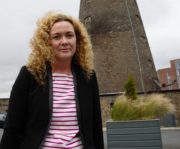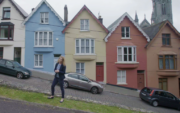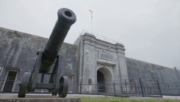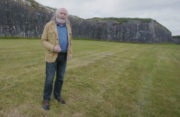Series Overview:
BUILDING IRELAND returns to explore and explain how Ireland’s great building and engineering achievements came to be, and their impact on the development of our towns and cities. In the company of an enthusiastic team of experts, the series marries local heritage with construction technology and engineering. Architecture, geography and engineering are the disciplines brought to bear; each programme focuses on a prime example of Ireland’s built heritage and recounts the fascinating story of its construction.
Episode 1:
Our first episode delves into the history of Spike Island, a prime defensive location in the middle of the second largest natural harbour in the world. Geographer Susan Hegarty sets the scene.
“CORK HARBOUR has been a world-class naval base, an industrial hub, and, for millions of emigrants, the last sight of Ireland they would ever see. As a geographer, I’m interested in the islands that dot this harbour. And this might just be the most important of them all; Spike Island, sometimes known as Ireland’s Alcatraz. I’ve come to this speck in the sea to see how this island had a role in defending an empire, and Building Ireland.” Susan Hegarty
The island, less than a kilometre long and barely half a kilometre wide, was initially barren, wild, and rugged. Why was this tiny speck of land so important that the British would place a naval base on the site? Susan speaks to historian Tom O’Neill to find out.
“Internationally the Cork harbour is ideally positioned to become almost an outpost for security for the south western approaches for the west coast of England and Wales. In Europe the Napoleonic threat was the big one, and Ireland was always seen as a potential back door where an enemy would attempt to use it as a base with which to invade the western side of England.” Tom O’Neill
Engineer Tim Joyce finds out exactly what kind of fortifications were built on the island, and how they functioned to defend from invaders.
“The fort was surrounded by a deep, dry moat, with a steep slope beyond. It’s a type of artificial slope known as a glacis – just flat enough to tempt invaders, but too steep for them to climb at speed. With shot and shell raining down from these ramparts, it would have been a stiff task to get anywhere near the walls, let alone overrun them.” Tim Joyce
Tim speaks with Commander Brian Fitzgerald of the Naval Service to learn more about Spike Island’s strengths when it came to the defence of the British Empire.
“With the high ground to the west, high ground to the east and the island in the centre, the arcs of fire that you can deliver around Cork harbour in and of itself makes the harbour impenetrable.” Commander Brian Fitzgerald
But the island wasn’t always a military fortress; by the 1840’s, Spike Island had become part of the Irish prison system, as Susan explains.
“Spike Island became a sort of penal colony, housing everyone from political prisoners to the homeless – victims of the vagrancy laws enacted at the height of the Famine.” Susan Hegarty
Susan speaks to historian Cal McCarthy, and archaeologist Dr Barra Ó Donnabháin from University College Cork who is conducting excavations across the island to find out more about what life would have been like for the prisoners of Spike Island’s prison.
“The wooden prison here was designed to take 200 men. But when it came here to Spike there was a problem with overcrowding and it ended up accommodating almost instantly, like the minute it opened, it had 400 men.” Dr Barra Ó Donnabháin
“This was supposed to be a temporary convict depot, 36 years later it was still a temporary convict depot and the military always insisted that anything built by the convicts would be built to their standards in order that it could be used as part of a military base later on. Indeed in this punishment block you can see the domed roofs in the cells. These cells are bomb-proof.” Cal McCarthy
“By 1850 we had about 2,500 men imprisoned here.
We’re digging here in the graveyard because the historical sources that are available to us about Spike Island really tell us the story from the perspective of the authorities. What we’re able to access here are the physical remains of the convicts themselves, and their physical remains, their skeletal remains contain information about their lives before they came into the prison system but also they give us information on the impact on their bodies of incarceration.” Dr Barra Ó Donnabháin
“I think maybe what’s unique about the island is this was once the home to the largest prison that has ever existed in Britain or Ireland.” Cal McCarthy
The harsh prison regime here on Spike Island stood in stark contrast to the Victorian splendour of Cobh on the other side of Cork Harbour. Architect Orla Murphy takes a look at the residential architecture of Cobh – a prosperous seaside town that developed from the local maritime trade.
“The Cobh we see today is a legacy of the social and economic shifts that followed in the wake of the famine. As the economy began to recover, a new, prosperous middle class came to the fore, leaving the squalor of the cities behind for the fresh air of rural Ireland. And Cobh, with its Royal Navy connections, was in the perfect place to take advantage of that boom.” Orla Murphy
Orla visits the most prominent example of this architecture, The Crescent, where she speaks to Mona Hallinan, the Architectural Conservation Officer for Cork County Council. The character of these houses is immediately evident.
“Very elite, very very elite. I think the way these places are designed reflects that. I mean The Crescent itself can be seen from everywhere in Cobh, and it’s overlooking the entire harbour. So while Cobh has fantastic views, not everybody had the views that you’re getting here. And it’s prominent, it’s overlooking, it can be seen from everywhere in the town so… It gives an idea of the high status of the people that lived here.” Mona Hallinan
Susan concludes with a reflection on how far Spike Island has come, from the fortress and prison, to what it is today.
“Today, the voices of Spike Island – the stories of its inmates, soldiers and sailors – are finally being heard. The ferry from Cobh brings curious visitors, not shackled prisoners bound for exile. But who knows what remains to be discovered, beneath the soil of Ireland’s Alcatraz?”
Presenters:
Tim Joyce is a practising Civil Engineer with a passionate interest in the way our predecessors got things done with limited resources and technology. He will investigate WHAT did they do and HOW did they do it?
Dr Susan Hegarty is a Physical Geographer with a fascination for the interaction of people with the landscape. She will explore WHERE did they do it and WHY?
Orla Murphy is an award-winning architect with an expert knowledge of civic buildings and industrial archaeology who can’t stop telling people about it. She will discover WHO did it and WHEN?







